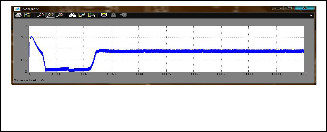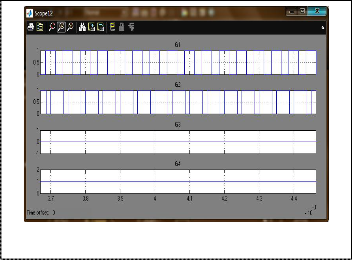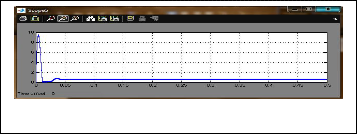
International Journal of Scientific & Engineering Research Volume 4, Issue3, March-2013 1
ISSN 2229-5518
Model Of Multiple Input Boost Converter For Renewable Energy System Using Matlab/Simulink L. Chitra, M. Nandhini, M. Karpagam
—————————— ——————————
ith increasing concern of global warming and the depletion of fossil fuel reserves, many are looking at sustainable energy solutions to preserve the earth for the future generations.
Other than hydro power, wind and photovoltaic energy holds the most potential to meet our energy demands. The common inherent drawback of wind and photovoltaic systems are their intermittent natures that make them unreliable. So, the number of applications which need more than one power source is increasing. Distributed generating systems or micro-grid systems normally use more than one power source or more than one kind of energy source. Also, to increase the utilization of renewable energy sources, diversified en- ergy source combination is recommended. For example, a wind- photovoltaic generating system, a combination of a wind generator and photovoltaic array, can give a greater degree of freedom when choosing the install location. The combination of more power sources and diversified power sources makes it possible to obtain higher availability in a power system. A parallel connection of con- verters has been used to integrate more than one energy source in a power system
The converter used for this type of applications is divided into multiple converter and multiple input converter.Multiple input con- verter has the following disadvantages,more number of switch- es,complex contol circuit,high cost.Multiple input converter is a de- vice that is used to integrate more than one source. A multiple-input converter (MIC) can generally have the following advantages com- pare to a combination of several individual converters. They are cost reduction, compactness, more expandability and greater manageabil- ity.Three port bidirectional converter advantages is magnetical
————————————————
Manuscript received November 29, 2012
L.Chitra is with the Deparment of Electrical & Electronics Engineer-
ing,Dr.Mahalingam college of Engineering & Technology,Pollachi-
3. e-mail:santum17@rediffmail.com.
M.Nandhini is with the Deparment of Electrical & Electronics Engi- neering ,Dr.Mahalingam college of Engineering & Technolo-
gy,Pollachi-3. e-mail:nadhiniadhesh@gmail.com.
ly coupled, multiple-port topology aiming at UPS applications [1]. The main drawback is it cannot handle wide variety of voltage range input. Also, there is a need for improving transients, dynamic charac- ter and peak power capacity[1].Multi-input converter for grid con- nected PV /Wind[2-6] has to control the multi-input inverter proper- ly, the central control unit, DSP, need to sense the input voltages, input currents, dc bus voltage, output voltage and output current con- tinuously. Therefore extra sensor is needed to realize these protection functions which is costly.Newly designed ZVS multi input converter has high switching losses and more number of switches[7].
In order to overcome the drawbacks of above said converters , Farzam Nejabatkhah[8] has proposed a converter in which it has the following advantages,only four switches and simple control circuit.
The paper is organized in the following sequence; proposed con- verter working is described in section1,the simulation results are described in section3.
The converter structure shows that when switches S3 and S4 are turned ON, their corresponding diodesD3 andD4 are reverse biased by the battery voltage and then blocked. On the other hand, turn-OFF state of these switches makes diodes D3 and D4 able to conduct in- put currents iL 1 and iL 2. In hybrid power system applications, the input power sources should be exploited in continuous current mode (CCM). For example, in the PV or FC systems, an important goal is to reach an acceptable current ripple in order to set their output pow- er on desired value. Therefore, the current ripple of the input sources should be minimized to make an exact power balance among the input powers and the load. Therefore, in this paper, steady state and dynamic behavior of the converter have been investigated in CCM In general, depending on utilization state of the battery, three power operation modes are defined to the proposed converter. These modes of operation are investigated with the assumptions of utilizing the same saw tooth carrier waveform for all the switches, and d3, d4
IJSER © 2013 http://www.ijser.org
International Journal of Scientific & Engineering Research Volume 4, Issue3, March-2013 2
ISSN 2229-5518

<min (d1,d2 ) in battery charge or discharge mode. Although ex- ceeding duty ratios d3 and d4 from d1 or d2 does not cause converter malfunction, it results in setting the battery power on the possible maximum values. In order to simplify the investigations, it is as- sumed that duty ratio d1 is less than duty ratio d2. Further, with the assumption of ideal switches, the steady-state equations are obtained in each operation mode.
Fig. 3.2 Output Voltage Vs Time At Load Side For First Operat- ing Mode

Fig. 3.3 Output Current Vs Time At Load Side For First Operat- ing Mode


Fig. 2.1Muli input Converter Farzam Nejabatkhah [8]
Multiple input boost converter is modelled using the blocks of
MATLAB Simulink and the results are presented in this section.

In this stage, the requirement of load power PL is 100W while the maximum available PVpower is 140W and the maximum available FC power is 150W.Thesun irradiation level is G = 750W/m2. There is no need to charge the battery. First, second, third and fourth duty ratios are set as d1=0.7, d2=0.75,d3=0 and d4=1. By setting d3 = 0 and d4 = 1, which result the battery power to be set on zero value. The FC current is regulated by d1, which shows iL1 =0.85A. The PVcurrent is regulated by d2, which shows iL2 =0.45A. The results are shown in the figure3.1, 3.2,3.3,3.4,3.5 and figure3.6.The required load voltage is maintained for its entire operating time.
Fig. 3.4 Solar Panel Output Current Vs Time For First Operating

Mode
Fig. 3.5 Fuel Cell Current Vs Time Output For First Operating
Mode

Fig. 3.6 Battery Output Voltage , Current Value Vs Time For First

Operating Mode
Fig. 3.1 Gate Pulse For Four Switches G1,G2,G3 And G4 Vs time
R © 2
Fig. 3.7 Comparison Of Voltages Of Solarcell, Fuelcell And Load
Vs Time
International Journal of Scientific & Engineering Research Volume 4, Issue3, March-2013 3
ISSN 2229-5518


shown in figure3.8,3.9,3.10,3.11,3.12 and 3.13.
Fig. 3.8 Load Output Voltage Vs Time For Second Operating Mode
Fig. 3.9 Gate Pulse For Four Switches G1,G2,G3 And G4 Vs

Time
Fig. 3.10 Simulation Diagram

In this stage, the sun irradiation level increase to G =1000W/m2, while the load power remains constant at PL = 100W. In addition, in this stage, the battery charging is assumed to be performed, so the third operation mode is chosen for the converter. In this condition, battery remains in charging due to increase in sun irradiation level. As shown in Figure, the battery has been charged. The FC current is regulated on iL1 = 8.85 to 0.9A with duty ratio d = 0.73, while the maximum power of the PV source is tracked with regulating the PV current at iL2 =0.3A and adjusting the first duty ratio at d1 = 0.79. Moreover, controlling the third and fourth duty ratios at d3 = 0.45 and d4 = 0, respectively, results in providing the charging power of the battery in addition to regulating the output voltage which are-
IJSER © 2013 http://www.ijser.org
Fig. 3.11 Load current Vs Time for second operating mode
International Journal of Scientific & Engineering Research Volume 4, Issue3, March-2013 4
ISSN 2229-5518
is delivered at iL2 =1.25 with adjusting the second duty ratio at d2
= 0.71. The controlling the third and fourth duty ratios at d3 = 1 and
d4 = 0.4 results in discharging the battery which are shown in figure
3.15.,3.16,3.17.

Fig. 3.12 Solar Panel Current Vs Time For Second Operating Mode


Fig. 3.13 Fuel Cell Current Vs Time For Second Operating Mode
Fig. 3.17 Gate Pulse For Four Switches G1,G2,G3 And G4 Vs Time
Fig. 3.14 Battery Charging Voltage,Current, SOC VsTime


Fig. 3.18 Load Current Vs Time For Third Operating Mode
Fig. 3.15 Comparison Of Voltages Of Solarcell, Fuelcell And Load
Vs Time

Fig. 3.19 Fuel Cell Output Current Vs Time For Third Operating

Fig. 3.16 Load Voltage Vs Time For Third Operating Mode
This stage occurs in a condition that solar power decreased to certain value in which the load requires PL =100W and the PV power is simultaneously decreased due to sun irradiation level of G = 500
W/m2. From the maximum deliverable power of the PV, it is obvi- ously understood that the PV is not able to completely supply the power deficiency thus the remained power should be supplied by the battery. Therefore, the second operation mode is chosen. The PV is accomplished by regulating its current at iL2 =0.24A and adjusting the first duty ratio at d2 = 0.73, while the maximum power of the FC
IJSER ©

Fig. 3.20 Solar Panel Output Current Vs Time For Third Operating
Fig. 3.21a Comparison Of Voltages Of Solar Cell, Fuelcell And Load
International Journal of Scientific & Engineering Research Volume 4, Issue3, March-2013 5
ISSN 2229-5518
From the results of three operating mode,the converter maintains a constant output irrespective of change in solar radiation,fuel cell availability.In the matlab,the control signals are given to the four switches according to the selection of inputs.
In this Paper multiple input boost converter for solar/fuel cell has been analyzed. A practical case with a constant output load of 100W developed in MATLAB [Simulink].Simulation platform has been presented and the results confirm the adequate performance of whole design. With the merits of flexibility, the proposed multiple input converter shows excellent performance and potential for various applications including communication systems, satellite, radar sys- tems.In future the same converter can be used to integrate wind and other type of renewable energy sources
[1] Duarte J. L, Hendrix M. and Simoes M. G.(2009) ‘Three-port bidirec- tional converter for hybrid fuel cell systems’,IEEE Transactions on Power Electronics ,vol. 22, no. 2, pp. 480–487.
[2] Chen Y. M, Liu Y. Ch, Hung S. C. and Cheng C. S.(2007) ‘Multi- input inverter for grid-connected hybrid PV/Wind power system’,IEEE Transactions on Power Electronics, vol. 22, no. 3, pp. 1070–1077.
[3] Kwasinski R.(2010) ‘Identification of feasible topologies for multiple- input DC–DC converters’, IEEE Transactions on Power Electronics, vol. 24, no. 3, pp. 856– 861.
[4] Matsuo H, Lin W, Kurokawa F, Shigemizu T. and Watanabe N. (2004)
‘Characteristics of the multiple-input DC–DC converter’,IEEE Trans- actions on Power Electronics, vol. 51, no. 3, pp. 625–631.
[5] Peng F .Z, Li H, Su G. J. and Lawler J. S.(2004) ‘A new ZVS bidirec-
tional dc–dc converter for fuel cell and battery application’,IEEE
Transactions on Power Electronics, vol. 19, no. 1, pp. 54–65.
[6] Sarhangzadeh M, Hosseini S. H, Sharifian M. B. B. and Gharehpetian G. B.(2011) ’Multi-input direct DC–AC converter with high frequency link for clean power generation systems‘,IEEE Transactions on Power Electronics, vol. 26, no. 6, pp. 1777–1789.
[7] Wai R. J, Lin Ch. Y, Liaw J. J, and Chang Y. R.(2011) ‘Newly de- signed ZVS multi-input converter’ IEEE Transactions on Power Elec- tronics, vol. 58, no. 2, pp. 555–566.
[8] Farzam Nejabatkhah, Saeed Danyali, Seyed Hossein Hosseini(2012)
‘Modeling and Control of a New Three-Input DC–DC Boost Con- verter for Hybrid PV/FC/Battery Power System’ , IEEE Transactions
on Power Electronics, vol. 27, no. 5
IJSER © 2013 http://www.ijser.org